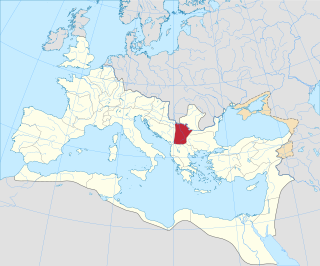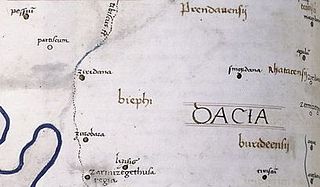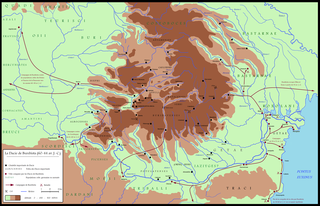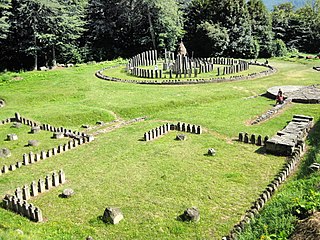
Dacia was the land inhabited by the Dacians, its core in Transylvania, stretching to the Danube in the south, the Black Sea in the east, and the Tisza in the west. The Carpathian Mountains were located in the middle of Dacia. It thus roughly corresponds to the present-day countries of Romania, as well as parts of Moldova, Bulgaria, Serbia, Hungary, Slovakia, and Ukraine.

Moesia was an ancient region and later Roman province situated in the Balkans south of the Danube River, which included most of the territory of modern eastern Serbia, Kosovo, north-eastern Albania, northern parts of North Macedonia, Northern Bulgaria, Romanian Dobruja and small parts of Southern Ukraine.

Sarmizegetusa Regia, also Sarmisegetusa, Sarmisegethusa, Sarmisegethuza, Ζαρμιζεγεθούσα (Zarmizegethoúsa) or Ζερμιζεγεθούση (Zermizegethoúsē), was the capital and the most important military, religious and political centre of the Dacians before the wars with the Roman Empire. Erected on top of a 1200 m high mountain, the fortress, comprising six citadels, was the core of a strategic defensive system in the Orăștie Mountains.

Built in murus dacicus style, the six Dacian Fortresses of the Orăștie Mountains, in Romania, were created in the 1st centuries BC and AD as protection against Roman conquest, and played an important role during the Roman-Dacian wars.

The Dacians were the ancient Indo-European inhabitants of the cultural region of Dacia, located in the area near the Carpathian Mountains and west of the Black Sea. They are often considered a subgroup of the Thracians. This area includes mainly the present-day countries of Romania and Moldova, as well as parts of Ukraine, Eastern Serbia, Northern Bulgaria, Slovakia, Hungary and Southern Poland. The Dacians and the related Getae spoke the Dacian language, which has a debated relationship with the neighbouring Thracian language and may be a subgroup of it. Dacians were somewhat culturally influenced by the neighbouring Scythians and by the Celtic invaders of the 4th century BC.
The Dacian Wars were two military campaigns fought between the Roman Empire and Dacia during Emperor Trajan's rule. The conflicts were triggered by the constant Dacian threat on the Danubian province of Moesia and also by the increasing need for resources of the economy of the Empire.

Stone walls are a kind of masonry construction that has been used for thousands of years. The first stone walls were constructed by farmers and primitive people by piling loose field stones into a dry stone wall. Later, mortar and plaster were used, especially in the construction of city walls, castles, and other fortifications before and during the Middle Ages. These stone walls are spread throughout the world in different forms. One of the best example is the Cyclopean Wall in Rajgir, India.

Murus gallicus or Gallic wall is a method of construction of defensive walls used to protect Iron Age hillforts and oppida of the La Tene period in Western Europe.

A Pfostenschlitzmauer is the name for defensive walls protecting Bronze Age and Iron Age hill forts and oppida in Central Europe, especially in Bavaria and the Czech Republic. They are characterized by vertical wooden posts set into the front stone facing. The rampart is constructed from a timber lattice filled with earth or rubble. The transverse cross-beams may also protrude through the stone facing, as with the murus gallicus used in Gaul and western Germany. It is sometimes referred to in English as a timber-framed wall.

The Moesian Limes is the modern term given to a collection of Roman fortifications between the Black Sea shore and Pannonia, present-day Hungary, consisting primarily of forts along the Danube to protect the Roman provinces of Upper and Lower Moesia south of the river.

Colonia Ulpia Traiana Augusta Dacica Sarmizegetusa was the capital and the largest city of Roman Dacia, later named Ulpia Traiana Sarmizegetusa after the former Dacian capital, located some 40 km away. Built on the ground of a camp of the Fifth Macedonian Legion, the city was settled by veterans of the Dacian wars. From the very beginning it received the title of colonia and the status of ius Italicum. With an area of 30 hectares, a population between 20,000 and 25,000, and strong fortifications, Ulpia Traiana was the political, administrative and religious centre of Roman Dacia in the 2nd and 3rd centuries.

Zurobara was a Dacian town located in the northwest of today's Romanian Banat. It was positioned by the Tibiscus (Timiș) river, north of Sarmizegetusa Regia and south of Ziridava.

Dava was a Geto-Dacian name for a city, town or fortress. Generally, the name indicated a tribal center or an important settlement, usually fortified. Some of the Dacian settlements and the fortresses employed the Murus Dacicus traditional construction technique.

The Battle of Sarmizegetusa was a siege of Sarmizegetusa, the capital of Dacia, fought in 106 between the army of the Roman Emperor Trajan, and the Dacians led by King Decebalus.

Ziridava was a Dacian town located between Apulon and Tibiscum, mentioned by Ptolemy in the area of the Dacian tribe of Biephi.

Situated at the top of a steep hill, the Dacian fortress of Căpâlna was built in the second half of the 1st century BC as a military defense, guarding the entrance from the Sebeș Valley to the capital of the Dacian kingdom, Sarmizegetusa Regia.

Piatra Roşie, which means Red Rock, was a Dacian hill fort two days march to the west from Costeşti-Cetăţuie fortress, at Luncani in Boşorod municipality. It was built in two phases. In the first phase a long rectangular main citadel was built at the height of land with watch towers on each end and two outlying watch towers. Later the larger area inside the watch towers was enclosed with walls. It appears that the hilltop was flattened in the process in order to produce a usable space.
Dacicus is a Latin word for "Dacian". It may also mean one of the following:
























